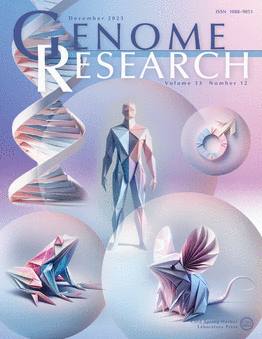长读序列揭示了HBV整合模式和对早发性肝细胞癌的致癌影响
IF 5.5
2区 生物学
Q1 BIOCHEMISTRY & MOLECULAR BIOLOGY
引用次数: 0
摘要
乙型肝炎病毒(HBV)整合是肝细胞癌(HCC)发生和进展的关键驱动因素;然而,由于检测方法和样本可用性的限制,其致癌机制仍不完全清楚。在这项研究中,我们采用牛津纳米孔技术(ONT)的全基因组测序和全长转录组测序来表征基因组和转录组水平上的HBV整合事件,以及它们对结构变异(SVs)和基因表达的调节作用。通过双荧光素酶测定和基于细胞的实验进行功能验证。我们的研究结果表明,整合的HBV序列形成长串联体,介导人类基因组的染色体间和染色体内重组。值得注意的是,整合HBV增强子I (HBV- enh I)在7个肿瘤组织中的6个中检测到,并与异常基因表达相关。HBV整合诱导局灶性MYC扩增和NAV2缺失等致癌性SVs,并直接调节基因表达。此外,在HBV-Enh I整合的驱动下,心肌的异位过表达促进了HCC细胞的迁移和侵袭。总之,HBV整合是大规模基因组SVs和转录组失调的主要驱动因素,通过直接改变基因组剂量或顺式调节机制。HBV-Enh I经常被整合到HCC中,可能在异常基因表达中起关键作用,突出了其作为治疗靶点的潜力。本文章由计算机程序翻译,如有差异,请以英文原文为准。
Long-read sequencing reveals HBV integration patterns and oncogenic impact on early-onset hepatocellular carcinoma
Hepatitis B virus (HBV) integration is a key driver of hepatocellular carcinoma (HCC) occurrence and progression; however, its oncogenic mechanisms remain incompletely understood because of limitations in detection methods and sample availability. In this study, we employed Oxford Nanopore Technologies (ONT) whole-genome sequencing and full-length transcriptome sequencing to characterize HBV integration events at the genomic and transcriptomic levels, along with their regulatory effects on structural variations (SVs) and gene expression. Functional validation was performed using dual-luciferase assays and cell-based experiments. Our findings revealed that integrated HBV sequences form long concatemers, mediating inter- and intrachromosomal recombination in the human genome. Notably, integrated HBV enhancer I (HBV-Enh I) was detected in 6 of 7 tumor tissues and was associated with aberrant gene expression. HBV integration induced oncogenic SVs, such as focal MYC amplification and NAV2 deletion, and directly modulated gene expression. Additionally, ectopic overexpression of MYOCD, driven by HBV-Enh I integration, promoted HCC cell migration and invasion. In summary, HBV integration acts as a major driver of large-scale genomic SVs and transcriptomic dysregulation, through either direct alterations in genome dosage or cis-regulatory mechanisms. HBV-Enh I is frequently integrated in HCC and might play a pivotal role in abnormal gene expression, highlighting its potential as a therapeutic target.
求助全文
通过发布文献求助,成功后即可免费获取论文全文。
去求助
来源期刊

Genome research
生物-生化与分子生物学
CiteScore
12.40
自引率
1.40%
发文量
140
审稿时长
6 months
期刊介绍:
Launched in 1995, Genome Research is an international, continuously published, peer-reviewed journal that focuses on research that provides novel insights into the genome biology of all organisms, including advances in genomic medicine.
Among the topics considered by the journal are genome structure and function, comparative genomics, molecular evolution, genome-scale quantitative and population genetics, proteomics, epigenomics, and systems biology. The journal also features exciting gene discoveries and reports of cutting-edge computational biology and high-throughput methodologies.
New data in these areas are published as research papers, or methods and resource reports that provide novel information on technologies or tools that will be of interest to a broad readership. Complete data sets are presented electronically on the journal''s web site where appropriate. The journal also provides Reviews, Perspectives, and Insight/Outlook articles, which present commentary on the latest advances published both here and elsewhere, placing such progress in its broader biological context.
 求助内容:
求助内容: 应助结果提醒方式:
应助结果提醒方式:


